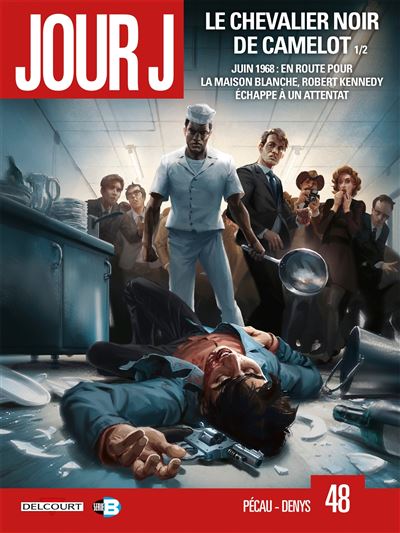What could be further away than dance, the art of movement and comics, the art of drawing? However, choreographer Sarath Amarasingam has the crazy idea of inviting Adrien Houillère to follow the creation of his show. This dialogue gives Finding Ganesh published by Delcourt.
Dancing to make a place
Finding Ganesh first appears as the story of a man, Sarath whom the comic book author renames Vimal Amarasingam out of modesty. The book begins with his innocuous childhood memories. As a young boy, he played baseball in rural Sri Lanka. But in fact this is the last time he will be able to do so because he leaves alone with his older brother for Europe and the rest of his family will join him only eight years later. He moved to Chambéry in France at the age of twelve. Both scriptwriter and cartoonist, Adrien Houillère does not make a journalistic comic or even a biography but dares an impressionist story. He does not multiply dialogues or texts, but by many empty boxes, he offers you a mental journey. Adrien Houillère adopts a vivid line like the traces of a (dance) step in the sand. When he leaves Sri Lanka, his parents offer him a coat but he does not understand what it will be used for. This will be the first of many culture shocks. Vimal operates a complete change of continent, landscape, climate and living environment from a countryside in a warm country to a city in the mountains of a temperate climate.  The title illustrates Vimal's journey because, after 28 years, Vimal had just returned from Sri Lanka. He wants to put on a show about his dual culture and his multiple attempts at integration. He changes his diet and even his name but he receives in his face that he will never be French enough. We feel Vimal divided between two opposing aspirations: to live in his community but to be locked in or out to integrate but deny his roots. He finds a solution to this paradox through education and dance. He started with hip-hop which he then mixed with Indian dance before moving on to contemporary dance.
The title illustrates Vimal's journey because, after 28 years, Vimal had just returned from Sri Lanka. He wants to put on a show about his dual culture and his multiple attempts at integration. He changes his diet and even his name but he receives in his face that he will never be French enough. We feel Vimal divided between two opposing aspirations: to live in his community but to be locked in or out to integrate but deny his roots. He finds a solution to this paradox through education and dance. He started with hip-hop which he then mixed with Indian dance before moving on to contemporary dance.
Drawing for dialogue
Adrien initially sees Vimal as a migrant before being an artist but quickly Finding Ganesh becomes the story of a human and artistic exchange. To illustrate the first meeting, Adrien Houillère uses two colors. It is represented in white and Vimal in ochre and each also has bubbles of different colors. The choreographer's words are very numerous but the two bubbles cross when there is an understanding. This play on color is one of the many graphic inventions of Finding Ganesh. The book is easy to understand but we feel that the author has thought the way to transcribe the sensations. Houillère plays with all the tools of sequential art: colors, layout, dialogue, recitative or pages without text. It makes the reader think when sometimes we do not understand all his choices. People have no eyes. Why?  Adrien begins his research on the internet with images and then on the history of Tamils. This part offers some benchmarks for us readers but quickly Vimal intervenes in the comic. For him, this past is not important and he refuses to talk about the past to focus on the double culture. The cartoonist finds the key when he sees Vimal dancing to the playwright's text. The page explodes with small boxes everywhere illustrating the movement but also the freedom of the dancer. The reader then goes behind the scenes of the creation of a show. Everything starts from an idea of the choreographer and then we see the different stages: the meeting of the designer, the exchanges with a playwright for the writing, the rehearsals, the spinning and the performances…Finding Ganesh is very conceptual. This book is at the same time a narrative and the method of making this narrative. After having exposed us to Vimal's dance, Houillère explains how he managed to draw these pages, what comes from dance and what is reconstructed, his difficulties in grasping it. Finding Ganesh is a powerful story about a human being looking for his place. Since he is denied a space, he pushes social barriers through his dance. His art is a tool for creation and expression. This beautiful book is also a dialogue of two men who together create a common work. If you want to understand the link between comics and other arts, you can read the chronicles on Claude Gueux and Minneapolis.
Adrien begins his research on the internet with images and then on the history of Tamils. This part offers some benchmarks for us readers but quickly Vimal intervenes in the comic. For him, this past is not important and he refuses to talk about the past to focus on the double culture. The cartoonist finds the key when he sees Vimal dancing to the playwright's text. The page explodes with small boxes everywhere illustrating the movement but also the freedom of the dancer. The reader then goes behind the scenes of the creation of a show. Everything starts from an idea of the choreographer and then we see the different stages: the meeting of the designer, the exchanges with a playwright for the writing, the rehearsals, the spinning and the performances…Finding Ganesh is very conceptual. This book is at the same time a narrative and the method of making this narrative. After having exposed us to Vimal's dance, Houillère explains how he managed to draw these pages, what comes from dance and what is reconstructed, his difficulties in grasping it. Finding Ganesh is a powerful story about a human being looking for his place. Since he is denied a space, he pushes social barriers through his dance. His art is a tool for creation and expression. This beautiful book is also a dialogue of two men who together create a common work. If you want to understand the link between comics and other arts, you can read the chronicles on Claude Gueux and Minneapolis.








































